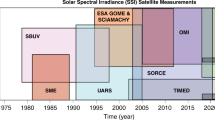Abstract
The ACRIM I experiment (Active Cavity Radiometer Irradiance Monitor) on the solar maximum Mission (SMM) satellite has provided a nearly continuous record of solar total irradiance variations since early 19801. It has detected variations on time scales ranging from minutes to SMM's lifetime. The long-term variations have revealed a downward trend during the declining phase of solar cycle 21 (ref. 2) of the sunspot cycle, a flat period between mid-1985 and mid-1987, and an upturn in late 1987 which suggests a direct correlation of luminosity and solar active region population. If the upturn continues into the activity maximum of solar cycle 22, a relation between solar activity and luminosity of possible climatological significance could have been discovered. The sense of the correlation agrees with what has been predicted from the coincidence of the 'little ice age' climate anomaly in the sixteenth and seventeenth centuries and the Maunder Minimum of solar activity3. The best-fit relationship for the variation of total irradiance S, with sunspot number Rz, and 10–cm flux F10, are S=1,366.82+7.7l×10−3 Rz and S=1,366.27+8.98×10−3 F10 (W m−2). These could be used to approximate total irradiance variations over the periods for which these indices have been compiled.
This is a preview of subscription content, access via your institution
Access options
Subscribe to this journal
Receive 51 print issues and online access
$199.00 per year
only $3.90 per issue
Buy this article
- Purchase on Springer Link
- Instant access to full article PDF
Prices may be subject to local taxes which are calculated during checkout
Similar content being viewed by others
References
Willson, R. C. Space Sci. Rev. 38, 203–242 (1984).
Willson, R. C., Hudson, H. S., Frohlich, C. & Brusa, R. W. Science 234, 1114–1117 (1986).
Eddy, J. A. Climate Change 1, 173–190 (1977).
J. R. Hickey in Advances in Absolute Radiometry (ed. Foukal, P. V.) 30–33 (AER, Cambridge, MA, 1985).
Willson, R. C., Gulkis, S., Janssen, M., Hudson, H. S. & Chapman, G. A. Science 211, 700–702 (1981).
Willson, R. C. J. geophys. Res. 86, 4319–4326 (1982).
Oster, L. F., Schatten, K. H. & Sofia, S. Astrophys. J. 256, 768–772 (1982).
Sofia, S., Oster, L. & Schatten, K. Solar Phys. 80, 87–89 (1982).
Chapman, G. A. in Solar Irradiance Variations on Active Region Time Scales (eds La Bonte, Chapman, Hudson & Willson) 73–89 (NASA, Washington, 1983).
Hirayama, T., Okamoto, T. & Hudson, H. S. ibid 43–58.
Hudson, H. S. & Willson, R. C. in The Physics of Sunspots (eds Cram, L. & Thomas, J.) 434–435 (Sacramento Peak Observatory, New Mexico, 1981).
Lean, J. L. et al. J. Geophys. Res. 87, 10307–10317 (1982).
Foukal, P. & Lean, J. Astrophys. J. (in the press).
Author information
Authors and Affiliations
Rights and permissions
About this article
Cite this article
Willson, R., Hudson, H. Solar luminosity variations in solar cycle 21. Nature 332, 810–812 (1988). https://doi.org/10.1038/332810a0
Received:
Accepted:
Issue Date:
DOI: https://doi.org/10.1038/332810a0
This article is cited by
-
Extreme solar events
Living Reviews in Solar Physics (2022)
-
Determination of short-period terms of total solar irradiance
Journal of Astrophysics and Astronomy (2019)
-
The Solar Cycle
Living Reviews in Solar Physics (2015)
-
Solar Cycle Variation in Solar Irradiance
Space Science Reviews (2014)
Comments
By submitting a comment you agree to abide by our Terms and Community Guidelines. If you find something abusive or that does not comply with our terms or guidelines please flag it as inappropriate.



